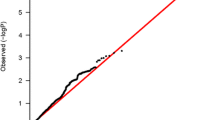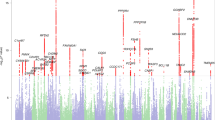Abstract
Genetic factors contribute substantially to the development of reading disability (RD). Family linkage studies have implicated many chromosomal regions containing RD susceptibility genes, of which putative loci at 1p34–p36 (DYX8), 2p (DYX3), 6p21.3 (DYX2), and 15q21 (DYX1) have been frequently replicated, whereas those at 3p12–q12 (DYX5), 6q13–q16 (DYX4), 11p15 (DYX7), 18p11 (DYX6), and Xq27 (DYX9) have less evidence. Association studies of positional candidate genes have implicated DCDC2 and KIAA0319 in DYX2, as well as C2ORF3 and MRPL19 (DYX3), whereas DYX1C1/EKN1 (DYX1) and ROBO1 (DYX5) were found to be disrupted by rare translocation breakpoints in reading-disabled individuals. Four of the candidate genes (DYX1C1, KIAA0319, DCDC2, and ROBO1) appear to function in neuronal migration and guidance, suggesting the importance of early neurodevelopmental processes in RD. Future studies to help us understand the function of these and other RD candidate genes promise to yield enormous insight into the neurobiologic mechanisms underlying the pathophysiology of this disorder.
Similar content being viewed by others
References and Recommended Reading
Shaywitz SE, Escobar MD, Shaywitz BA, et al.: Evidence that dyslexia may represent the lower tail of a normal distribution of reading ability. N Engl J Med 1992, 326:145–150.
Wood FB, Grigorenko EL: Emerging issues in the genetics of dyslexia: a methodological preview. J Learn Disabil 2001, 34:503–511.
Williams J, O’Donovan MC: The genetics of developmental dyslexia. Eur J Hum Genet 2006, 14:681–689.
Abecasis GR, Noguchi E, Heinzmann A, et al.: Extent and distribution of linkage disequilibrium in three genomic regions. Am J Hum Genet 2001, 68:191–197.
Reich DE, Cargill M, Bolk S, et al.: Linkage disequilibrium in the human genome. Nature 2001, 411:199–204.
Risch NJ: Searching for genetic determinants in the new millennium. Nature 2000, 405:847–856.
Manolio TA, Brooks LD, Collins FS: A HapMap harvest of insights into the genetics of common disease. J Clin Invest 2008, 118:1590–1605.
Taipale M, Kaminen N, Nopola-Hemmi J, et al.: A candidate gene for developmental dyslexia encodes a nuclear tetratricopeptide repeat domain protein dynamically regulated in brain. Proc Natl Acad Sci U S A 2003, 100:11553–11558.
Hannula-Jouppi K, Kaminen-Ahola N, Taipale M, et al.: The axon guidance receptor gene ROBO1 is a candidate gene for developmental dyslexia. PLoS Genet 2005, 1:e50.
Cook EH Jr, Scherer SW: Copy-number variations associated with neuropsychiatric conditions. Nature 2008, 455:919–923.
Smith SD, Kimberling WJ, Pennington BF, et al.: Specific reading disability: identification of an inherited form through linkage analysis. Science 1983, 219:1345–1347.
Grigorenko EL, Wood FB, Meyer MS, et al.: Susceptibility loci for distinct components of developmental dyslexia on chromosomes 6 and 15. Am J Hum Genet 1997, 60:27–39.
Schulte-Korne G, Grimm T, Nothen MM, et al.: Evidence for linkage of spelling disability to chromosome 15. Am J Hum Genet 1998, 63:279–282.
Morris DW, Robinson L, Turic D, et al.: Family-based association mapping provides evidence for a gene for reading disability on chromosome 15q. Hum Mol Genet 2000, 9:843–848.
Chapman NH, Igo RP, Thomson JB, et al.: Linkage analyses of four regions previously implicated in dyslexia: confirmation of a locus on chromosome 15q. Am J Med Genet B Neuropsychiatr Genet 2004, 131B:67–75.
de Kovel CG, Franke B, Hol FA, et al.: Confirmation of dyslexia susceptibility loci on chromosomes 1p and 2p, but not 6p in a Dutch sib-pair collection. Am J Med Genet B Neuropsychiatr Genet 2008, 147:294–300.
Platko JV, Wood FB, Pelser I, et al.: Association of reading disability on chromosome 6p22 in the Afrikaner population. Am J Med Genet B Neuropsychiatr Genet 2008, 147B:1278–1287.
Nopola-Hemmi J, Taipale M, Haltia T, et al.: Two translocations of chromosome 15q associated with dyslexia. J Med Genet 2000, 37:771–775.
Wigg KG, Couto JM, Feng Y, et al.: Support for EKN1 as the susceptibility locus for dyslexia on 15q21. Mol Psychiatry 2004, 9:1111–1121.
Marino C, Citterio A, Giorda R, et al.: Association of short-term memory with a variant within DYX1C1 in developmental dyslexia. Genes Brain Behav 2007, 6:640–646.
Cardon LR, Smith SD, Fulker DW, et al.: Quantitative trait locus for reading disability on chromosome 6. Science 1994, 266:276–279.
Petryshen TL, Kaplan BJ, Liu MF, et al.: Absence of significant linkage between phonological coding dyslexia and chromosome 6p23–21.3, as determined by use of quantitative-trait methods: confirmation of qualitative analyses. Am J Hum Genet 2000, 66:708–714.
Deffenbacher KE, Kenyon JB, Hoover DM, et al.: Refinement of the 6p21.3 quantitative trait locus influencing dyslexia: linkage and association analyses. Hum Genet 2004, 115:128–138.
Meng H, Smith SD, Hager K, et al.: DCDC2 is associated with reading disability and modulates neuronal development in the brain. Proc Natl Acad Sci U S A 2005, 102:17053–17058. (Published erratum appears in Proc Natl Acad Sci U S A 2005, 102:18763.
Cope N, Harold D, Hill G, et al.: Strong evidence that KIAA0319 on chromosome 6p is a susceptibility gene for developmental dyslexia. Am J Hum Genet 2005, 76:581–591 (Published erratum appears in Am J Hum Genet 2005, 77:898.)
Francks C, Paracchini S, Smith SD, et al.: A 77-kilobase region of chromosome 6p22.2 is associated with dyslexia in families from the United Kingdom and from the United States. Am J Hum Genet 2004, 75:1046–1058.
Fagerheim T, Raeymaekers P, Tonnessen FE, et al.: A new gene (DYX3) for dyslexia is located on chromosome 2. J Med Genet 1999, 36:664–669.
Petryshen TL, Kaplan BJ, Hughes ML, et al.: Supportive evidence for the DYX3 dyslexia susceptibility gene in Canadian families. J Med Genet 2002, 39:125–126.
Fisher SE, Francks C, Marlow AJ, et al.: Independent genome-wide scans identify a chromosome 18 quantitativetrait locus influencing dyslexia. Nat Genet 2002, 30:86–91.
Petryshen TL, Kaplan BJ, Fu Liu M, et al.: Evidence for a susceptibility locus on chromosome 6q influencing phonological coding dyslexia. Am J Med Genet 2001, 105:507–517.
Seshadri S, DeStefano AL, Au R, et al.: Genetic correlates of brain aging on MRI and cognitive test measures: a genome-wide association and linkage analysis in the Framingham Study. BMC Med Genet 2007, 19(Suppl 1):S15.
Hsiung GY, Kaplan BJ, Petryshen TL, et al.: A dyslexia susceptibility locus (DYX7) linked to dopamine D4 receptor (DRD4) region on chromosome 11p15.5. Am J Med Genet B Neuropsychiatr Genet 2004, 125B:112–119.
Rabin M, Wen XL, Hepburn M, et al.: Suggestive linkage of developmental dyslexia to chromosome 1p34–p36. Lancet 1993, 342:178.
de Kovel CG, Hol FA, Heister JG, et al.: Genomewide scan identifies susceptibility locus for dyslexia on Xq27 in an extended Dutch family. J Med Genet 2004, 41:652–657.
Rosen GD, Bai J, Wang Y, et al.: Disruption of neuronal migration by RNAi of Dyx1c1 results in neocortical and hippocampal malformations. Cereb Cortex 2007, 17:2562–2572.
Tapia-Paez I, Tammimies K, Massinen S, et al.: The complex of TFII-I, PARP1, and SFPQ proteins regulates the DYX1C1 gene implicated in neuronal migration and dyslexia. FASEB J 2008, 22:3001–3009.
Wang Y, Paramasivam M, Thomas A, et al.: DYX1C1 functions in neuronal migration in developing neocortex. Neuroscience 2006, 143:515–522.
Galaburda AM, Sherman GF, Rosen GD, et al.: Developmental dyslexia: four consecutive patients with cortical anomalies. Ann Neurol 1985, 18:222–233.
Schumacher J, Anthoni H, Dahdouh F, et al.: Strong genetic evidence of DCDC2 as a susceptibility gene for dyslexia. Am J Hum Genet 2006, 78:52–62.
Van Den Eynde BJ, Gaugler B, Probst-Kepper M, et al.: A new antigen recognized by cytolytic T lymphocytes on a human kidney tumor results from reverse strand transcription. J Exp Med 1999, 190:1793–1800.
Munroe SH: Diversity of antisense regulation in eukaryotes: multiple mechanisms, emerging patterns. J Cell Biochem 2004, 93:664–671.
Meng H, Smith SD, Hager K, et al.: DCDC2 is associated with reading disability and modulates neuronal development in the brain. Proc Natl Acad Sci U S A 2005, 102:17053–17058.
Burbridge TJ, Wang Y, Volz AJ, et al.: Postnatal analysis of the effect of embryonic knockdown and overexpression of candidate dyslexia susceptibility gene homolog Dcdc2 in the rat. Neuroscience 2008, 152:723–733.
Paracchini S, Steer CD, Buckingham LL, et al.: Association of the KIAA0319 dyslexia susceptibility gene with reading skills in the general population. Am J Psychiatry 2008, 165:1576–1584.
Paracchini S, Thomas A, Castro S, et al.: The chromosome 6p22 haplotype associated with dyslexia reduces the expression of KIAA0319, a novel gene involved in neuronal migration. Hum Mol Genet 2006, 15:1659–1666.
Velayos-Baeza A, Toma C, da Roza S, et al.: Alternative splicing in the dyslexia-associated gene KIAA0319. Mamm Genome 2007, 18:627–634.
Doyle AE, Ferreira MA, Sklar PB, et al.: Multivariate genomewide linkage scan of neurocognitive traits and ADHD symptoms: suggestive linkage to 3q13. Am J Med Genet B Neuropsychiatr Genet 2008, 147B:1399–1411.
Stein E, Tessier-Lavigne M: Hierarchical organization of guidance receptors: silencing of netrin attraction by slit through a Robo/DCC receptor complex. Science 2001, 291:1928–1938.
Andrews W, Barber M, Hernadez-Miranda LR, et al.: The role of Slit-Robo signaling in the generation, migration and morphological differentiation of cortical interneurons. Dev Biol 2008, 313:648–658.
Anthoni H, Zucchelli M, Matsson H, et al.: A locus on 2p12 containing the co-regulated MRPL19 and C2ORF3 genes is associated to dyslexia. Hum Mol Genet 2007, 16:667–677.
Ramos RL, Bai J, LoTurco JJ: Heterotopia formation in rat but not mouse neocortex after RNA interference knockdown of DCX. Cereb Cortex 2006, 16:1323–1331.
Author information
Authors and Affiliations
Corresponding author
Rights and permissions
About this article
Cite this article
Petryshen, T.L., Pauls, D.L. The genetics of reading disability. Curr Psychiatry Rep 11, 149–155 (2009). https://doi.org/10.1007/s11920-009-0023-z
Published:
Issue Date:
DOI: https://doi.org/10.1007/s11920-009-0023-z




